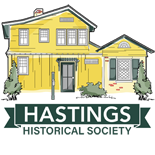
By Mark Sameth
In the dead of night, well past one in the morning, President Abraham Lincoln passed through Hastings on a secret trip from Washington, DC to West Point. It was June 24, 1862, in the midst of the Civil War, and the President was on his way to meet with the aged and infirm retired General Winfield Scott, who resided in the summer months about a mile and a half south of West Point at Cozzen’s West Point Hotel, about matters undisclosed.
This was Abraham Lincoln’s second passage through Hastings-Upon-Hudson (as it was known then). His first passage had been as President-Elect on February 19, 1861 (about that, see my blog post here). The third time would be his return trip the next day, June 25, 1862 (discussed later in this post). The last time would be aboard his funeral train on April 25, 1865 (see Greg Smith’s Winter 2012 article in the Hastings Historian here).
June 24 and 25, 1862 are President Lincoln’s least well-known passages through our Village. They took place 160 years ago this month.
Lincoln’s Second Passage Through Hastings, June 24, 1862
Lincoln’s second passage through the Village was, as noted, a clandestine affair. After news got out about the trip (it could not long be kept secret and was already reported on by The New York Times in brief on June 25), the Times opened its lengthy June 26 article with the sentence “The President is given to unannounced journeying.”
Lincoln was accompanied on this secret journey only by Colonel (later Major General) Daniel C. McCallum, Superintendent of the United States Military Railroad, and Lincoln’s personal valet, William Henry Johnson.


It would be the President’s longest journey away from the White House and his only trip to New York State during his presidency. The special train carrying the President, Col. McCallum and Mr. Johnson left from Washington, DC’s B&O Depot on New Jersey Avenue at 4 pm on Monday, June 23.

A little after 1 am the next morning, President Lincoln and his travelling companions arrived in Jersey City – the fastest time a train had ever travelled between these two cities. And then, unobserved in the darkness, they were ferried across the Hudson River to New York City.

A carriage, which had been waiting on the Manhattan side, took Lincoln, Johnson and McCallum to the 30th Street Train Depot between 9th and 10th Avenues. “No one met him, no one knew him, and he reached the depot at Thirty-first-street [sic] with but little detention.” There at the depot, they immediately boarded a special train that was waiting to take them up the Hudson.

The President and his companions had been travelling some 10-1/2 hours when, at around 2:30 am, the train sped northbound through Hastings-Upon-Hudson on its way to Garrison. Hours earlier, Mr. Samuel Sloan, President of the Hudson River Railroad, had received a telegram at West Point with the cryptic message: “Prepare to receive a brother president.” He and General Winfield Scott – whom Sloan had alerted, correctly surmising that this “brother president” was not a fellow railroad president, but rather President Lincoln, and that it was Scott whom the President was on his way to see – were waiting.


Sloan ferried across from West Point to the Garrison side of the river and found General Scott at dinner. Alarmed at the prospect of being paid a surprise visit by President Lincoln, both assumed the worst: doubtless “some dread crisis was upon the nation.” Together, Sloan and Scott then rode from the restaurant down to the ferry boat to await the presidential party.

The President’s Arrival and Visit
There at the river, according to The New York Times,
“… in great agitation the General … wrapped in his martial cloak … waited in the boat… Mr. Sloan walked the platform and waited. Hour after hour sped away. [Finally] at 3 o’clock on Tuesday mornidg [sic]… the whistle of the ‘special’ was heard and in a moment the train thundered in… Mr. Sloan received [the President] at the hands of Col. McCullum [sic], and conducted him to his host.
‘My dear General, I’m glad to see you, there’s nothing wrong I assure you, I have only come up to see and talk with you,’ said Mr. Lincoln, as with hearty grasp he caught and shook the trembling veteran’s hand. ‘Mr. President,’ rejoined Gen. Scott, whose face gave evidence of strong emotion, ‘I am truly glad to see yon [sic] and to know that all is well.’
The boat was unmoored and the delighted ferrymen carried in safety to West Point the two men from whom, above all others it may be said, this country expected great deeds, wise counsel, and sterling patriotism. Arrived at West Point they took, accompanied by Messrs. Sloan and Belcuer, a carriage and drove to Cozzen’s Hotel.”

Nothing was wrong? The President had only come up to see and talk with the General? The President had made a secret train ride in the middle of the night in the midst of the Civil War for a … social visit? That perhaps was what General Scott was wondering as the carriage carried him, Sloan, and the President up the steep hill from the ferry boat landing to the hilltop hotel.

As The Times reported, “the President was weary with much travel, the General had stayed up long after his bed-time and was tired out, and both did exactly what any other men would have done in a similar case – they retired from public life and went to bed.”

After but a few hours of rest, the President was by 7 am already at breakfast. He then went into conference with General Scott for some five hours to talk about … well, again, we really don’t know. The New York Times reported that the President had broached a number of subjects with the General, including “the possibility of a somewhat more active life on the part of the Lieutenant-General than he now leads.” What would “a somewhat more active life” have meant in the midst of the war, given the General’s well-known infirmities? Wherefore and why?


After breakfast, the President was given a tour of the grounds. He then returned to Cozzen’s Hotel for a private late lunch with General Scott, Professor Mahan of the West Point Academy, and Mr. Sloan, which was “served up,” in the words of the Herald Tribune, “in the sumptuous style for which Mr. Cozzens is so justly celebrated.”


The President and his party then ferried back across the river to Cold Spring, where he toured Gouverneur Kemble’s West Point Foundry. The foundry was, at the time, busy producing huge Parrot guns for the Union Army.

After touring the Foundry, the President and his party repaired to Mt. Kemble’s home “Marshmoor” (1817) for refreshments. The grandly named house was described as architecturally “unpretentious” and “plain.” The only known photograph of it is a stereogram circa 1860s in the Kemble family papers. (It may be seen online, reproduced in “Mr. Lincoln’s Secret Visit to West Point: The Sesquicentennial of a Military Mission” by Anthony j. Czarnecki in New York History: Quarterly Journal of the New York State Historical Association, Winter 2012, on page 30.)
That night, back at Cozzens’ Hotel, the President attended a reception quickly organized by women guests of the hotel. There, he reportedly dispensed autographs freely. No doubt the autograph seekers were delighted, if wondering themselves: what was the purpose of the President’s visit?
Lincoln’s Third Passage Through Hastings, June 25, 1862
Lincoln’s third passage through Hastings was his return trip from West Point (a decidedly more public affair than the outbound trip) the following morning, June 25, 1862.
By then, news that the President was at West Point had already made the papers and the trip from West Point back to Washington was done in the broad light of day. After taking breakfast and briefly sight-seeing on the river, the President was ferried back to the Garrison station where, after a salute of welcome, he boarded the train. It departed immediately. Col. McCallum and presidential valet William Henry Johnson were on board. So too were General Scott, railroad president Samuel Sloan, and a number of others who had joined the party for the initial leg of the journey. Was there more that the President needed to speak with General Scott about? Was that why the General was accompanying the President on the first leg of his journey back?
Along the route between Garrison and Tarrytown, according to the New York Herald, “very few people seemed to be aware of the important personages the special train contained.” In daylight, the President could see many of the sights he had seen the year before when the Inaugural Express had carried him southward along the Hudson River on his way from Troy to New York City, headed for Washington, DC. About 15 minutes into this journey the train passed Peekskill where, as President-elect, Lincoln had 16 months earlier given a short speech.

About 20 minutes later, just north of Tarrytown, the train passed Rockwood Hall, the Gothic Revival castle of William Henry Aspinwall, co-founder of the Panama Canal Railway (later it would be William Rockefeller’s summer home).

Moments later they were in Tarrytown where – unlike the towns and villages through which they had so far passed – “a great crowd was assembled and, as the train flew past, shouts of ‘Three cheers for Abe Lincoln’, ‘Hurrah for General Scott’, etc. rose high above the din and confusion occasioned by the engine. The President and General Scott bowed in response to these plaudits of the people.” A few minutes more and the train passed what today is the Lyndhurst estate. (At the time it was half the size by which we know it today, and known as “Knoll”).

Image courtesy of lyndhurst.org.
From this point on, according to The New York Times, “at every station crowds gathered to see the head of the Nation. Old men ‘God-blessed’ him; old ladies smiled sweetly upon him; men cheered him lustily; women handed him bouquets, and looked ‘kiss-me’quick,’ while boys – and in fact all children, shouted till their cheeks were red.” They passed the home of the late Washington Irving (owner, from 1814 to 1817, of property in downtown Hastings).

Shortly before 10 am, they passed through Dobbs Ferry. They passed Ingleside, one of the great mid-19th-century A. J. Jackson Gothic Revival “Hudson River Castles.” (It survives; it is home today to the St. Christopher’s School.)

Soon-to-be Rear Admiral David Farragut’s wife Virginia and their 17-year-old son Loyall lived in Hastings at the time. It is not hard to imagine them as among the cheering crowds. Farragut was an anti-secessionist seafaring Southerner and had relocated his family here just before the war. In June of 1862, Captain Farragut had just a month earlier captured New Orleans. Congress would honor him by creating the rank of “Rear Admiral” (never before used by the U. S. Navy) and appointing him to it on July 16 of that year. All the more reason to think that Virginia and Loyall were likely among those cheering and God-blessing the President when the train passed through our Village at almost precisely at 10 am.


And then it was on past Yonkers, over the trestle bridge at Spuytun Duyvil, and into the city, destination: 30th Street Depot. From there the President and his small entourage continued by ferry to New Jersey, and thence to Washington, DC.
The purpose of the secret visit? To this day, we do not know.

Of the three who made the trip – the President, Col. McCallum, and the President’s personal valet William Henry Johnson – only Mr. Johnson would not survive the war. He died suddenly in 1864, and was buried at Arlington National Cemetery, President Lincoln having made the arrangements. Mr. Johnson was African-American, and the inscription on his tombstone defies the Supreme Court’s 1857 Dred Scott decision. It says: “CITIZEN.”

Mark Sameth is a long-time resident of Hastings with an interest in all things historical. An ordained rabbi, he is the author of “The Name: A History of the Dual-Gendered Hebrew Name for God.”









This was a well-done article. Thank you for all your hard work.
Great article, unfortunately the pictures didn’t come with it ??
Wait a minute!! Just scrolled back and pictures appeared?? Good stuff!!